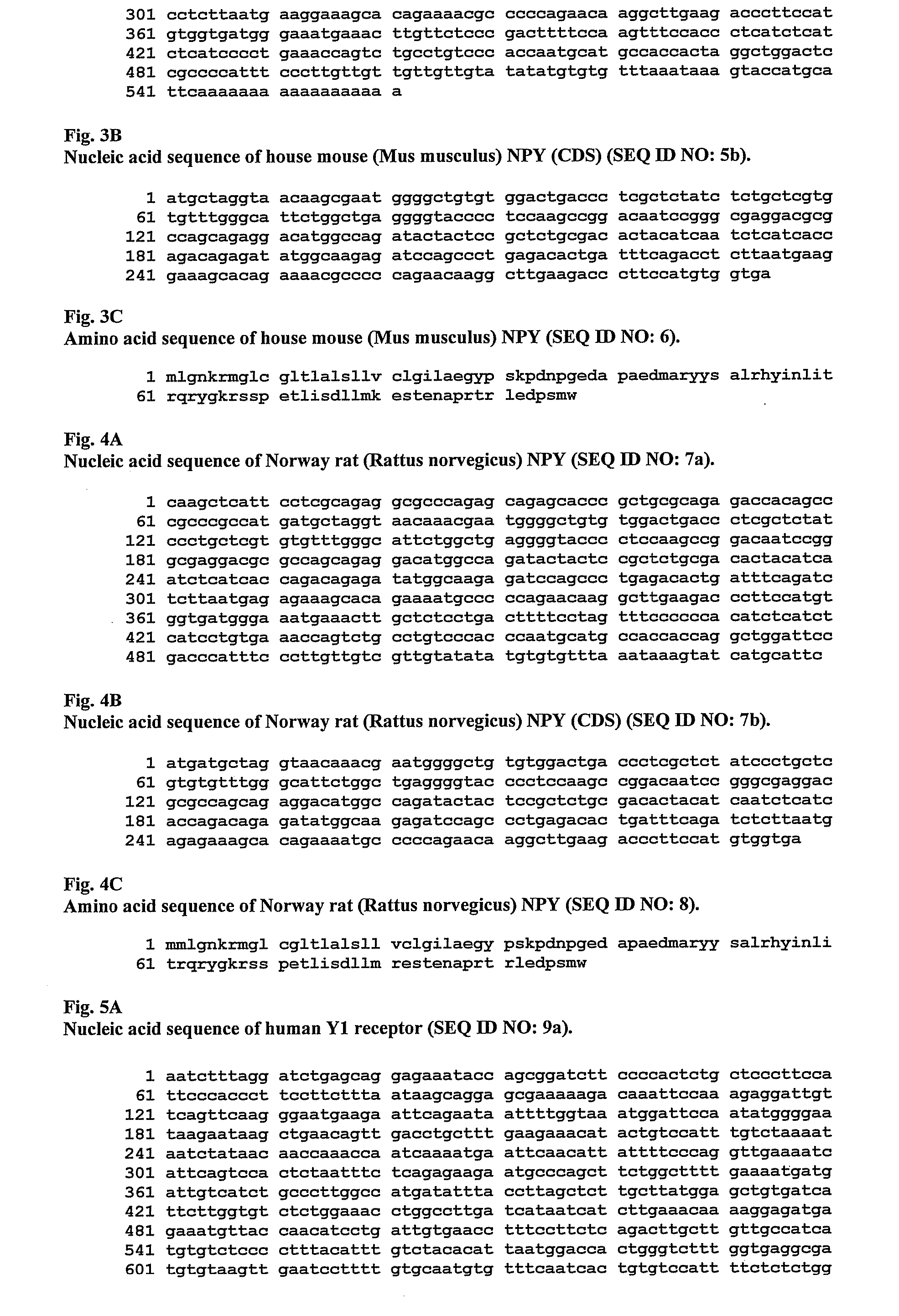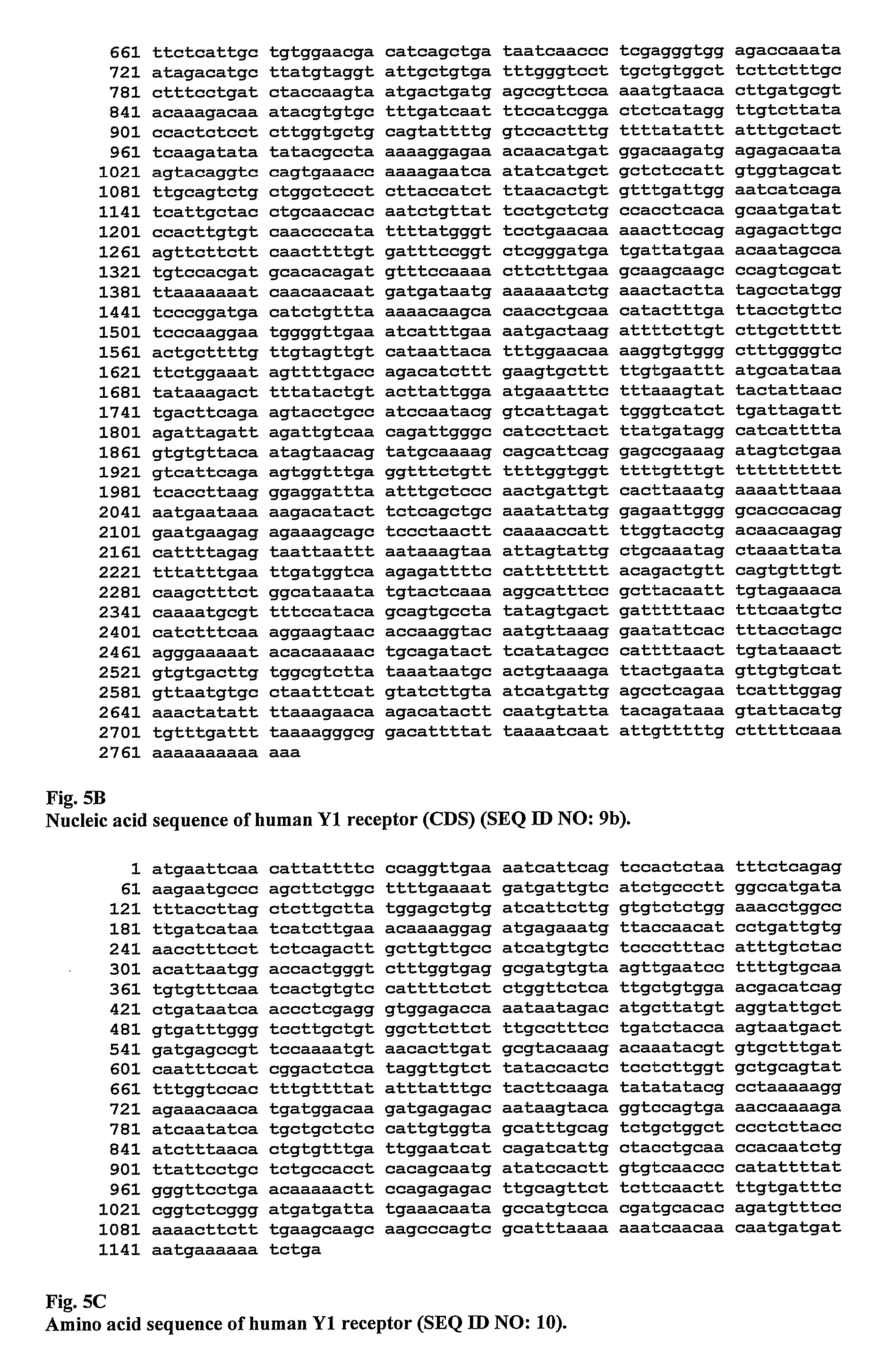Use of nucleic acid sequences for the treatment of neuralogical and psychiatric diseases and compositions
- Summary
- Abstract
- Description
- Claims
- Application Information
AI Technical Summary
Benefits of technology
Problems solved by technology
Method used
Image
Examples
examples
[0083]The main rationale for the present patent application is the treatment of epilepsy and psychiatric disease by strengthening signalling for the neuropeptide ligands NPY, galanin, and / or somatostatin in the CNS by overexpressing the neuropeptides and their corresponding receptors in different combinations at the same time. Moreover, this approach will also minimize the risk for downregulation of the receptors due to increased neuropeptide ligand effect.
[0084]We have now produced lentiviral vectors for mouse NPY, Y2, and Y5 receptor genes. We have also acquired commercially AAV serotype ½ vectors expressing NPY, Y2, and galanin. We will transfect mouse and rat hippocampus or other brain regions uni- or bilaterally by a combination of these genes: e.g., NPY+Y2 or NPY+Y5 or NPY+Y2+Y5 or NPY+galanin.
[0085]The experiments are or have been performed as follows:
example i
Traditional Electrical Kindling in Mice
[0086]Adult mice are implanted with stimulation electrodes in the left hippocampus and kindling is performed according to the traditional protocol, one stimulation per day. Once mice are fully kindled (after about 3-4 weeks), we test the threshold for the induction of generalized seizures. After the last kindling stimulation, i.e., threshold detection, mice are infused by combinations of the viral vectors (see above) into the hippocampus bilaterally. Four to five weeks later, the threshold for seizure induction is tested and, subsequently, five kindling stimulations are delivered by traditional method. Seizure severity, latency to behavioural seizures, afterdischarge duration and secondary afterdischarge duration and number is analyzed and compared to pre-transfection values. A control group of mice with the infusion of viral vectors lacking corresponding genes are used as additional controls. Another control group consists of a single viral ve...
example ii
Kainate Seizures in Mice
[0088]In the next series of experiments, these combinations of the viral vectors are tested in the kainate-induced status epilepticus (SE) model. The vectors are infused into the hippocampus uni- or bilaterally, and, after 4-5 weeks, kainate (20-40 mg / kg) is injected intraperitoneally and the mice are observed for motor seizures, seizure severity and duration, latency to seizures and mortality. These parameters are compared to the control group of mice infused with NPY only or empty viral vectors.
Expected Results II
[0089]We expect that mice infused with NPY+Y2, NPY+Y5 and NPY+Y2+Y5 viral vectors will display a lower number of motor seizures, longer latency to seizures (FIG. 67), lower mortality (FIG. 68), and decreased seizure severity as compared to NPY only or empty viral vector-infused mice.
PUM
| Property | Measurement | Unit |
|---|---|---|
| Fraction | aaaaa | aaaaa |
| Fraction | aaaaa | aaaaa |
| Time | aaaaa | aaaaa |
Abstract
Description
Claims
Application Information
 Login to View More
Login to View More - R&D
- Intellectual Property
- Life Sciences
- Materials
- Tech Scout
- Unparalleled Data Quality
- Higher Quality Content
- 60% Fewer Hallucinations
Browse by: Latest US Patents, China's latest patents, Technical Efficacy Thesaurus, Application Domain, Technology Topic, Popular Technical Reports.
© 2025 PatSnap. All rights reserved.Legal|Privacy policy|Modern Slavery Act Transparency Statement|Sitemap|About US| Contact US: help@patsnap.com



